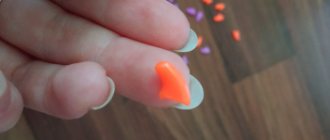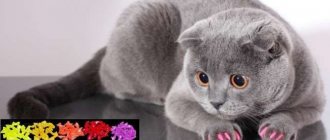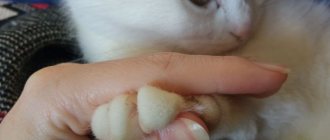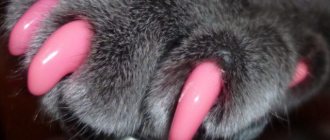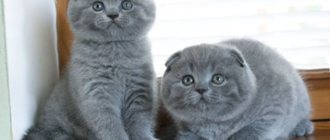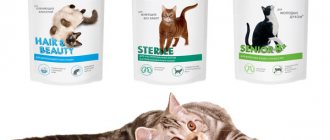Anti-scratch guards for cats are designed to protect surrounding objects and household members from the sharp claws of a pet. Popular silicone pads come in 4 sizes and can be used on kittens from 4 months of age (size XS for babies). To fix them, a special glue is used, which is included in the kit and does not cause allergies.
The service life of the covers is 1-1.5 months. It is not allowed to be worn for up to 4 months, if you are allergic to glue and for animals that walk outside, if there is a fungus or infection on the claws. On average, for a set of 40 nozzles you will have to pay up to 400 rubles.
An alternative to anti-scratch treatments can be a repeller spray (Beaphar Stop-it Cat, Biovax, Anti-scratch) and training the cat to use a scratching post.
What kind of device are anti-scratchers for cats?
Owners owe the appearance of silicone caps on the pet supply market to the American veterinarian Toby Wexler. He was against the inhumane method of declawing and figured out how to avoid it. This happened in 2003.
Appearance
The tips are made of silicone, which does not contain toxic elements. They are created in such a way that they fully correspond to the anatomical shape, repeating all the curves. The tips themselves do not injure the paw and do not even prevent the retraction of the claw. Now there is a wide range on sale:
- different colors (red, green, yellow, purple, black);
- transparent;
- fluorescent (glow in the dark);
- with sparkles.
The caps are attached with medical glue, which is absolutely safe for any living beings. If your pet chews and tries to swallow its accessory, then no harm will come from it. Anti-scratch pads can be used not only for cats, but also for small breed dogs.
Purpose
Silicone accessories, which were invented in the USA, are widely distributed throughout the world. For now, this is the only humane way to save furry owners from troubles with damaged wallpaper, furniture and curtains. But combating damage to things is not the only purpose of anti-scratch products for cats. They are successfully used in the following situations:
- Health problems for the owner or his family members. Diseases include problems with blood clotting or allergies of various types.
- Presence of small children in the apartment. Kids can provoke even the most phlegmatic fluffy into aggression. Silicone kits will help protect your child from injury.
- Aggressive cats. Some animals, due to their breed or character traits, can rush at people at the slightest irritation. Also, pets with illnesses may demonstrate hostility towards humans before recovery.
You should not purchase tips just for their attractive appearance. If the pet is not mischievous or does not demonstrate inappropriate behavior, then the use of such devices is not relevant.
average price
Cat claw caps are sold in sets of 20 or 40 pieces. The kit comes with instructions and medical glue. The average cost of a set is 250-350 rubles. (for 20 pieces).
If the price is an order of magnitude lower, then this is a reason to doubt the quality of the devices. Usually, kits with low-quality glue are cheaper, which can become unsafe, causing allergies or poisoning.
Lining life
It is assumed that the anti-scratches last for approximately 1.5-2 months: it is during this time interval that a healthy animal replaces old claws with new ones (provided that the cat is very lazy and inactive).
The caps will last about 14 days for a normal, cheerful and playful cat. A nervous, angry, quick-witted cat who does not tolerate violence will tear off the pads with his teeth without waiting for the end of their service life. With this development of events, “soft claws” often end up in the cat’s stomach. After traveling through the gastrointestinal tract, they come out on their own without causing harm to the cat.
The cost of a set of 20 anti-scratch pads is 200-300 rubles, sometimes the set includes not 20, but 40 pieces, which doubles the service life.
Return to content
The benefits and harms of caps
Any pet product has both positive and negative characteristics. This is explained by the peculiarity of mustaches, their individual needs and character, as well as the preferences of the owner.
Undeniable advantages
The positive aspects of wearing silicone pads are obvious, and there are quite a lot of them. The main thing is that the mustache normally perceives their presence on its paws and does not try to chew them off. Advantages of devices:
- keeping furniture, walls and curtains in good condition;
- lack of possibility of causing injury to a person;
- Can be used at any age.
When worn correctly, these cute little silicone things won't cause any discomfort to your furry friend. Over time, he will stop paying attention to them, and then the owner will be completely calm about the safety of his home.
Possible disadvantages
Of course, there are also negative sides to using tips. However, they can be avoided with the correct selection of accessories. It is important to consider not only the attractive appearance of the product, but also how comfortable the mustache is.
The disadvantages that may arise include:
- fragility (maximum month, and average service life - 2 weeks);
- different period of adaptation - the cat may never get used to the innovation;
- they squeak unpleasantly or knock on the floor when walking or burying the tray;
- possible deformation of the nail plates, their separation.
Fluffy purrs, like people, have different mentalities. Therefore, the period of adaptation for some pets may take a couple of weeks, while others will forget about the caps in just a couple of hours.
Age restrictions
Manufacturers of products for mustachioed consumers claim that there are no restrictions on the use of stickers. However, veterinarians do not agree with this. In their opinion, it is not advisable to use kits for kittens up to six months of age. Their nail plates themselves are very soft and easily wear off when walking or playing.
Nail caps are not useful for older cats. Old people usually lose interest in curtains and pieces of furniture, so there is no point in protecting them.
The same can be said about free-ranging animals. An individual who spends a lot of time outdoors will not be able to climb a tree or protect itself from enemies if cute accessories are put on it.
Reviews from veterinarians about anti-scratch products for cats
In addition to ordinary cat lovers, it is worth asking the opinion of veterinarians on the issue of cats wearing rubber caps. The opinion of experts is not so rosy, since in any case, for cats, the procedure of gluing the pads is equal to stress.
A cat under natural conditions can grind its claws down if necessary, but a kitty with a bright manicure is forcibly deprived of this instinctive ability. This is also stressful for the animal. You should not think that the purr is adapting - most likely, this is not adaptation, but humility.
Veterinarians do not recommend anti-scratch kits for cats that have the opportunity to walk - in case of danger, she will not be able to defend herself and climb a tree.
Choice among variety
The right product successfully replaces the removal or trimming of the nail plate. The main thing is to guess the size and buy harmless glue.
Size is the most important thing
When purchasing, you need to take into account the weight and thickness of the nail plate of the homemade mustache. A sizing guide can be found on any package with caps. Conventionally, there are 4 types:
- For small animals and kittens (up to 1.5 kg) – the smallest size is XS.
- For fluffies weighing from 1.5 to 4 kg, S is suitable.
- For individuals with a body weight of 4-6 kg, size M is intended.
- For large breeds or dogs weighing more than 6 kg, use size L.
High-quality products are made from thin and pliable silicone, which does not wear out for a long time and does not cause discomfort to the cat. Cheap analogues quickly crack, fly off and cause a lot of inconvenience. Therefore, quality and size are the determining factors when purchasing protective devices.
What about glue?
Not only the material from which the pet product is made is important, but also the glue included in the set. This substance should do more than just keep the cap on the animal's paw. The comfort of wearing devices depends on the quality of the glue. If it contains harmful components or is expired, then irritation and inflammation may occur from its use.
When purchasing a kit, you need to make sure that the glue included in the kit has a medical purpose and a good shelf life. If the product was purchased a long time ago, then the spoiled composition can be replaced with the appropriate one from the pharmacy.
Advantages and disadvantages
Not only their owners can benefit from the use of anti-scratch products for cats. There are positive features for animals too.
Pros:
- longer need to worry about the safety of new renovations and interior items.
- When bathing or treating an animal, you can avoid unpleasant consequences in the form of deep scratches on the body, which the cat will leave in a state of stress. In any other case, you can also be sure that the cat will not be able to injure the owner and family members either on purpose or intentionally.
- Protecting small children from pet claws.
- No age restrictions.
Minuses:
- fragility - generally the caps last for a maximum of a month, after which replacement is necessary;
- adaptation to anti-scratch;
- the likelihood of deformation of the nail plates and inflammation.
How to use
The first attempt to use overlays is not always successful. But this does not mean that you should give up silicone caps - you should be persistent and not give up.
Preparing animal claws
To carry out the first stickers, it is important to enlist the support of one of the family members. This will make the first attempt more successful and less traumatic.
First, you need to carefully examine the claws of your furry friend. They often differ in length, so the tip is tried on each finger separately.
A little pressure is applied to the paw pad so that the cat opens it, after which 2-3 mm of the claw is cut off with special nippers. The cut can be sharpened with a soft file, then there will be no sharp edges left.
Next, try on the overlay. It is important to make sure that it is pressed tightly and that there is 2 mm left to the base of the claw. Tips that are too long can be shortened slightly to make them easier to wear. To do this, the edges are trimmed with nail scissors.
In long-haired cats, long fur between the toes often gets in the way. In order not to stain it with glue, it is recommended to cut off any protruding hairs immediately before the procedure.
Algorithm for gluing procedure
Detailed instructions on how to glue anti-scratch pads to cats' claws are included with each kit. It is the same for protective sets of any size and color. The gluing algorithm looks like this:
- Glue is poured inside the lining, which should fill no more than half of it.
- By pressing on the pad with your fingers, you need to release the claw so that it appears at its full length.
- Step back 2 mm from the base and put on the tip, avoiding any glue getting on the fur.
- Hold for up to 10 seconds for better adhesion.
- Do not let go of your pet for 5-7 minutes so that the glue dries completely and sets.
During the procedure, the cat should experience a minimum of discomfort. Otherwise, re-sticking will not arouse positive expectations in him, and then it will be difficult to force him to this procedure.
Precautionary measures
It is more convenient and safer for the owner to use protective nails only on the front paws of the pet. This is also rational - it is with them that fluffies cause harm to surrounding objects.
The hind legs can be left alone. As a last resort, they can be filed or lightly trimmed.
During the procedure, the mustachioed friend must be securely fixed so that he cannot harm the person, run away during the procedure, or get dirty in the glue. It is better to stick the caps together: one holds, the other performs manipulations. You can’t put too much pressure on your pet, much less cause him pain.
After complete drying, watch your pet so that he does not actively chew the silicone. Distract your furry one with a treat or game.
Do not let the glue come into contact with your own hands or the cat's fur. The glue will be difficult to wash off, so it is better to use gloves or an old blanket in which you can wrap a restless animal.
Instructions for use
Before moving on to active actions, take the cat in your arms and win him over by scratching behind the ear, soft intonations and other methods known to you. Remember that at first the pet will not be delighted with the manipulations being performed. The calmer the cat is at first, the higher the likelihood of coping quickly and painlessly for both.
It's rare that an owner can put the attachments on correctly the first time.
By the way! At first, you may not be confident in your abilities. Then contacting a specialist would be the best solution. The veterinarian will tell you and clearly show you how to properly fix the attachment on the claw and how deeply to put it on.
If you decide to heroically take control of the situation, then here is the procedure.
Table 1. Gluing anti-scratch tapes in four stages
| Action | Details |
| Decide on the correct size of attachment according to the size of the claw. Place the cat's paw in your hand. Lightly press the pad of the foot with your index finger, holding the top of the claw with your thumb, so as to release the claw. Place the cap on the claw. The cap should completely cover the surface of the claw | |
| Trim claws or caps if necessary. If the attachments are large, shorten them on the side of the claw hole with scissors. If the attachments are small, adjust the claws themselves. You need to trim the narrowest tip of the claw (1-2 mm), otherwise you risk touching the blood vessels located in the claw | |
| Squeeze glue onto the inside surface of the cap. The glue should fill one third of the volume of the cap. Be prepared for the fact that glue may get on furniture and clothes, and choose your workplace in advance with this in mind. It is recommended to fill all the caps with glue at once. | |
| Place the caps on the claws. Press the pad of the paw so that the pet extends the claw out. Place the attachments on the claws using a sliding motion. Next, press each cap against the sides of the claw for ten seconds to allow the glue to dry and adhere. Sit with your pet in your arms for 5 minutes for better adhesion of the caps. |
Established contact with your pet before starting the operation of gluing attachments will make it easier.
By the way! Before starting the procedure, it is recommended to wipe your pet’s claws with a disinfectant to get rid of dirt and germs. Pre-cleaning will allow the attachments to last longer.
Video - Glue anti-scratch pads on claws
Size
Anti-scratch pads are not universal. There are four types of attachments in total, they are selected according to the size of the pet.
Table 2. Nozzle sizes
| Nozzle size | Breed | Weight |
| XS | Kittens up to six months | 0.5-2.5 kg |
| S | Sphynx, Siamese cat | 2-4 kg |
| M | Persian, British, Siberian | 4-6 kg |
| L | Maine Coon, Bengal, Savannah | 6 kg or more |
By the way! Despite the fact that attachments are also available for very young pets, they do not require anti-scratch protection. The kittens’ claws themselves are still soft in order to somehow additionally block them. Plus, they are constantly growing.
How to remove attachments?
In most cases, owner involvement is not required. Sooner rather than later, the attachments fall off naturally, and more often they are completely chewed off. Manufacturers talk about several months of wearing, but in practice this period is usually shortened.
A pet's initial hostility to anti-scratchers is completely natural.
At first, the owner needs to be prepared to put on the attachments again after a couple of days. When the pet gets used to it (which does not happen with all cats - due to different temperaments), the attachments will require changing every one and a half to two months - this is the natural cycle of changing claws.
The cat will get used to the attachments faster if the claw is trimmed correctly before gluing the cap.
The procedure for changing attachments is as follows:
- Carefully cut the cap, being careful not to touch your pet's claw.
- After cutting off the tip, cracks will appear in the rest of the material, after which it will easily fall off.
- Remove remaining particles of material with a nail file.
- Blot your paw with hydrogen peroxide.
- If wounds appear, lubricate them with healing ointment.
How often do you need to change the pads?
You should not remove the caps yourself, especially if this is not associated with a threat to health and life. The additional manipulation of removing the tips will cause further stress for the cat. Objective factors that require ridding the animal of protective kits are:
- allergic reaction;
- improper gluing;
- prolonged nervousness.
It is important to understand that this is not only decoration. They cannot be changed when the owner is tired of the appearance. A person’s whim is not a reason to subject an animal to an unnecessary procedure.
Contraindications, possible complications
If the cat is accustomed to a scratching post, does not show aggression and does not damage furniture, it may not need anti-scratch claws.
There are a number of restrictions that make it better to avoid sticking protective caps. Veterinarians indicate the main ones:
- The animal is walking on the street. In case of danger, the cat will not be able to defend itself or climb a tree.
- Allergic reaction to glue. Symptoms of intolerance may occur immediately or after a few days. To help in a timely manner, it is necessary to periodically examine the cat for the appearance of redness or irritation.
- The presence of dermatitis or fungal diseases. Anti-scratch pads can only be applied to the claws of a healthy cat.
- Age of the kitten. If there is a need to use caps for an animal that is less than six months old, it is better to consult a veterinarian.
- Prolonged stress. When a cat has lost interest in food and games, it is better not to aggravate the situation.
Duration of use
Protective accessories fall off the paws on their own as the nail plate grows. Therefore, their service life is related to the health, lifestyle and behavior of the cat. On average, the period of wearing the kit lasts from 2 to 4 weeks, and sometimes reaches 2 months.
In some cases they may be lost. The eared friend leaves them in the long pile of the carpet or chews them off.
Expert advice
The procedure for gluing claw covers is best done with someone in pairs . One holds the cat, the second glues anti-scratch pads.
If your pet likes to kick, wrap it in a thick blanket. At the end of the cosmetic session, keep an eye on the cat: if she tears off (gnaws off) a couple of pads, glue on new ones. But if there is a persistent rejection of manicure and nervousness that lasts more than 3 days, leave the animal alone.
An alternative to “soft claws” is a regular scratching post. In the end, give the cat an old leather suitcase, an ironing board, or... resign yourself to a tattered sofa and walls.
Return to content
Anti-scratch vs surgery, scratching post and trimming
In addition to protective kits, the pet store also offers other means designed to save your home from destruction: sprays, special pheromones, which, alas, do not always work.
Another effective, but completely unacceptable for any pet, method is onychectomy - surgical removal of the claw and part of the finger. This is a very dangerous procedure that leads to dire consequences. The cat becomes disabled and cannot lead a full life and take care of itself. Many animals lose their mental health after onychectomy, which is why the operation is prohibited by law in some countries.
A scratching post becomes a solution if the cat has been trained to use it. In other cases, it simply does not work - or the pet uses both the scratching post and the owner’s favorite chair.
Trimming nails is only partially effective. Claws grow quickly, and they sharpen even faster. They have to be trimmed with a nail file all the time, and this takes a long time. Not every cat will sit for 10 minutes and endure the unpleasant procedure.
Therefore, protective kits become the best alternative. They can be used regularly, or for a short period of time - for example, during a trip, a long stay with relatives with small children, or a visit to the veterinarian.
Anti-scratch alternative
An alternative to anti-scratching can be a cat repellent spray, training the animal to use a scratching post, or special socks.
Anti-scratch spray
Anti-scratch sprays contain repellent substances, such as essential oils, which furry creatures do not like. The most popular repeller sprays among owners are Beaphar Stop-it Cat, Biovax, Antiscratch (True Friend) and Antiscratch pheromones for cats.
Scratchy
A scratching post or scratching post is a device for grinding down claws in apartment living conditions. You can purchase a horizontal or vertical modification at a pet store. Most often, jute rope, sisal, and corrugated cardboard are used for its production. Some pets will like a wooden scratching post.
Getting used to using the device will not be difficult if you buy a finished product specially impregnated with aromatic agents.
What do veterinarians say?
There are no clear reviews among veterinarians about anti-scratch products for cats. But most doctors tend to recommend them for their mustachioed patients.
Common Myths
Despite the fact that manufacturers insist that silicone claws are completely safe for the health of your mustachioed friend, there are quite a lot of myths about their use. Here are the most common reasons why owners do not want to purchase the “soft paws” accessory:
- The claws itch underneath. This is incorrect because there are no nerve endings on the nail plate.
- They interfere with retracting the claws. In fact, everything is attached to the tip, which sticks out of the pad.
- The animal's gait changes greatly. This is true, but not for all cats and for a very short period of time.
- The material and glue are toxic. Manufacturers and veterinarians say this is not true. Even ingestion cannot harm your pet.
To make use as comfortable as possible, it is necessary to follow the order of gluing them. In addition, when choosing silicone kits at a pet store, it is important to carefully read their composition and instructions.
How to put on your cat's nails
You should put false nails on your cat after the claws have been trimmed. If separation of the stratum corneum is observed, then it is necessary to trim the surface with a file.
How to properly glue a cat's nails
The following instructions will help you glue your cat’s nails correctly:
- prepare 5 silicone caps from the package;
- apply a small amount of glue into the cavity of the nozzle (no more than 1/3 of the volume);
- disinfect the claws on the cat’s paw with an antiseptic;
- Having pressed on the crumb, extend the claw and place the cap on it, gently pressing it on all sides;
- similarly glue attachments to all the pet’s claws;
- when the anti-scratch for the cat is glued, the animal should be held so that the glue sets, and after 10-15 minutes the cat with false nails can be released;
- Glue from the owner's fingers can be removed with nail polish remover.
If the pet is mischievous and breaks out, then you can attract an assistant and wrap the cat in a blanket for the procedure.
Anti-scratch for cats: instructions on how to use
There are no special instructions for using anti-scratch pads for cats; the animal simply wears them until they either rip them off or they fall off along with the renewal of the nail. If your pet chews and eats the cover, it’s okay. It will come out naturally without damaging the walls of the stomach and intestines.
Anti-scratch glue
Glue is included with the cases. A non-toxic product is used to attach silicone tips. In rare cases, the glue used to attach false nails can cause an allergy in your cat.
How to remove anti-scratch pads from a cat's claws
You can remove scratch guards from your cat’s claws when the stratum corneum of the claw grows back. In this case, the nozzle disappears on its own. This happens after about 1-2 months, depending on the intensity of the natural processes of claw regrowth in the cat.
If you need to remove them a little earlier, then you need to carefully trim the tip of the cover and pull it off.
Description of claw pads
Anti-scratches will be needed if the animal cannot be trained, ignores the scratching post, and continues to spoil the interior of the house.
When to use overlays:
- The cat expresses aggression towards strangers, attacks guests, and does not allow itself to be touched during a veterinary examination.
- Does not feel boundaries in games, attacks, scratches family members.
- Doesn't want to put up with the appearance of a new pet, rushes, injures the animal.
- Reacts aggressively to excessive petting by children; preschoolers do not know how to properly handle animals.
- Scratches the skin in case of dermatitis, eczema, diseases are accompanied by severe itching.
Cat pads are caps made of soft material that are filled with non-toxic glue and placed on the animal's claws. They were invented by the American veterinarian Wexler as a counterbalance to the brutal operation of onychectomy, surgical removal of claws. A cat with pads will not be able to tear wallpaper, damage furniture, curtains, or scratch people or animals.
The number of claws that need to be hidden under the covers depends on the cat's habits and behavior. When she tears up interior items, the caps are placed on her front paws. All claws are covered if the cat climbs onto the curtains or scratches with its hind paws while playing.
After gluing the anti-scratch pads, the cat does not experience pain, itching, and there are no nerve endings in the stratum corneum.
The animal continues to sharpen its claws on the furniture, but the upholstery remains unharmed. If the caps are glued correctly, the cat will still be able to retract its claws, the gait changes during the first 3 days, then it recovers.
The caps are not removed, they last a month, then fall off along with the old stratum corneum; if the cap comes off, a new one is glued on. If accidentally swallowed, the smooth nozzle moves freely throughout the gastrointestinal tract and comes out naturally after bowel movement.
Advantages and disadvantages
Negative side
The opinions of veterinarians and pet owners regarding such silicone accessories for cats are divided. Many consider this only a whim of the owners who deprive the animal of its instincts. They also emphasize that at first the pet experiences discomfort, it is difficult for him to walk and it is unusual for him to feel a foreign object on his paws. Some cats cannot tolerate adhesives, which can cause an allergic reaction. In addition, veterinarians say that a cat's paws are the animal's natural weapon and defense, which helps it fight off dogs and other cats on the street. Therefore, pets who like to walk around the yard are not advised to glue cat claw covers.
Sometimes such devices contribute to injury to the animal if its claw gets caught on something.
Sometimes scratching is harmful to a pet's health. It happens that a cat clings to something with its claws while playing, then the anti-scratch prevents it from escaping. From panic, the animal begins to thrash and this leads to the scratch coming off along with the claws. If the cap is the wrong size, it can grow into your pet's skin. And also, in trying to get rid of the product, the cat may accidentally swallow it.
